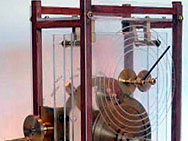But earlier this week, a team of British, Greek and U.S. researchers identified a set of corroded bronze gears that suggest Ptolemy and his pals may have been sporting something more like a Rolex than a sundial.
The device, known today as the Antikythera mechanism, has been acknowledged as the world's earliest existing computer, possibly dating back to the first century B.C.

A reconstruction of what it may have looked like.
The process of dating the relic hasn't been easy, and for decades, scientists dismissed the mechanism as being developed far more recently.
In 1960, when physicist Derek de Solla Price suggested that ancient Greeks, not 20th century Americans, developed the ancestor of the modern personal computer, he was widely dismissed in scientific circles. Now, the Greeks' innovation is finally being recognized.
...A century ago, divers off the coast of southern Greece discovered the hidden treasure in a shipwreck. Among the corroded ruins, they found more than 30 bronze gears on the ocean floor, preserved but encased in layers of rust that had built up over 2,000 years.

...Price was not the first to analyze the Antikythera mechanism — but like so many others inspired by its mystery, it became his obsession. His youngest son, Mark, recalled the hours his father spent working with cardboard models trying to reconstruct the device.
"My whole life, I remember him tinkering, and it was like one of those math puzzles you couldn't quite solve," Mark Price said. "I remember him at the dining room table trying to think of what it could be and, 'Is there another piece I'm missing?'"
In 1974, after nearly 10 years of searching for the missing piece to the ancient puzzle, Price found what he thought was the answer. Using crude X-ray technology, he was able to look inside the wall of rust and identify inscriptions written in ancient Greek that epigraphers pinpointed to the first century B.C.
...The most recent findings were released by a team of researchers who, like Price, were infatuated with the mysterious object.
Mike Edmunds, professor of astrophysics at the University of Cardiff in Wales, headed up the multinational group of scientists...
...In his work on the Antikythera mechanism, Price battled critics who called him a heretic for presenting extreme theories but persisted that his research would one day be validated. Price's son recalled the frustration his father expressed nearing his death in 1984.
"I remember when my father got to the end of his life and was looking back at all of his work and what he was famous for," he said. "And he was so frustrated that his really big accomplishment was practically invisible — and that was his work on the Antikythera mechanism."
...For Price's family, years of persistence have finally paid off. His son said the recent attention surrounding the Antikythera mechanism has validated his father's lifelong dedication.
"He had such perseverance and determination that even the most scholarly minds in the world saying that on this one item he was a crackpot and crazy, he felt passionately about it," he said. "And I really think that it's opened up our view of where technology comes from in a whole new light."
Read the rest here.
And another description from here:
"We have used the latest technology available to understand this mechanism, yet the technological quality in this mechanism puts us to shame," project leader Mike Edmunds, professor of astronomy at Cardiff University. "If the ancient Greeks made this, what else could they do?"
...Edmunds said the 82 surviving fragments, dated to between 140-100 B.C, contain more than 30 gear wheels, and "are covered with astronomical, mathematical and mechanical inscriptions."
"It was a calendar of the moon and sun, it predicted the possibility of eclipses, it showed the position of the sun and moon in the zodiac, the phase of the moon, and we believe also it may have shown the position of some of the planets, possibly just Venus and Mercury," he said.
The box-shaped mechanism — the size of office paper and operated with a hand-crank — could predict an eclipse to a precise hour on a specific day.
The new study of the ancient device, with the aid of Hewlett Packard and the British X-ray equipment maker X-Tek, more than doubled the amount of the inscriptions readable on the mechanism.
"We will not yet be able to answer the question of what the mechanism was for, although now we know what the mechanism did," Edmunds said.
His fellow team member, Xenophon Moussas, an associate professor of space physics at Athens University, speculated that the device could have been used for navigation at sea or for mapmaking.
The first comparable devices known in the West were clockwork clocks developed during the Middle Ages.
Nature magazine suggested that the know-how for these medieval clocks may have reached Europe from the east after the fall of Baghdad — capital of a highly cultured, prosperous Islamic state — to the Mongols in the 13th century.
The Antikythera device was probably made on the island of Rhodes, which had a long tradition in astronomy and applied mechanics.